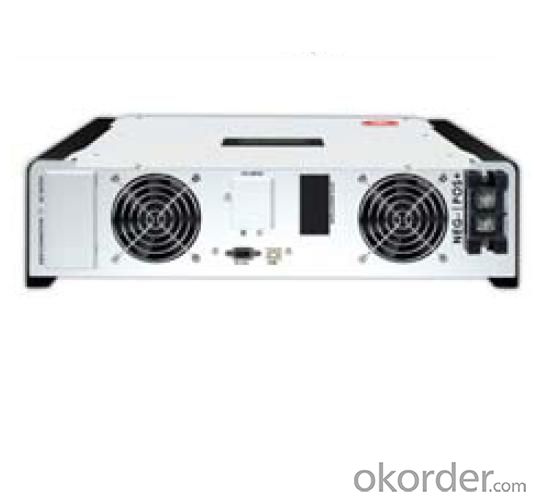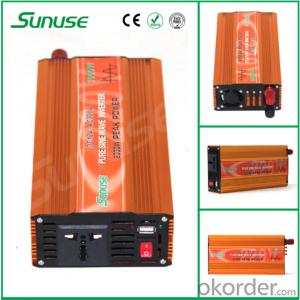Upgrade Solar Inverter Hybrid Inverter Sunbrid 3000 OEM Designed
- Loading Port:
- Guangzhou
- Payment Terms:
- TT OR LC
- Min Order Qty:
- 10 pc
- Supply Capability:
- 3000 pc/month
OKorder Service Pledge
OKorder Financial Service
You Might Also Like
Sunbrid 2000/3000 hybrid solar inverter can be use as on grid solar inverter or off grid inverter.
1.futures
Multiple operations: Grid-tied, off-grid, and grid-tied with battery backup
•Solar power usage priority selectable
•Built-in MPPT solar charger
•Intelligent control to guarantee stable system charging
•Comprehensive information from LCD display
2.datasheet
| MODEL | Sunbrid 2000 | Sunbrid 3000 |
| RATED POWER | 2000 W | 3000 W |
| GRID-TIE OPERATION | ||
| PV INPUT (DC) | ||
| Nominal DC Voltage | 300 VDC | 360 VDC |
| Maximum DC Voltage | 350 VDC | 500 VDC |
| Start-up Voltage / Initial Feeding Voltage | 80 VDC / 120 VDC | 116 VDC / 150 VDC |
| MPP Voltage Range | 120 VDC ~ 320 VDC | 120 VDC ~ 450 VDC |
| Maximum Input Current | 15 A | 13 A |
3.Certificate
ISO
CE
TUV
4.PRODUCT OUTLOOK

1. How long will my inquiry get response?
Your inquiry related to our products or prices will be replied within 24 hours.
2. Can I get professional service and suggestion?
Well-trained and experienced staffs to answer all your questions in fluent English.
3. Do you accept OEM or customized design?
OEM & ODM, any your customized lightings we can help you to design and put into product.
4. What if I need specific design?
Distributorship are offered for your unique design and some our current models.
- Q: Can a solar inverter be used in areas with high levels of electromagnetic interference (EMI)?
- Yes, a solar inverter can be used in areas with high levels of electromagnetic interference (EMI) as long as it is properly shielded and designed to withstand such conditions. However, it is important to choose an inverter that meets the necessary EMI compliance standards to ensure reliable and efficient operation in these environments.
- Q: Are there any government incentives for installing a solar inverter?
- Yes, there are government incentives available for installing a solar inverter. Many countries offer tax credits, grants, or subsidies to promote the use of renewable energy sources like solar power. These incentives aim to encourage homeowners and businesses to adopt solar energy systems, including solar inverters, by offsetting the initial installation costs and promoting sustainability. It is advisable to check with local authorities or consult renewable energy organizations to understand the specific incentives available in your region.
- Q: Can a solar inverter be used in a building-integrated photovoltaic system?
- Yes, a solar inverter can be used in a building-integrated photovoltaic system. A solar inverter is an essential component in any photovoltaic system as it converts the direct current (DC) produced by the solar panels into alternating current (AC) that can be used to power electrical devices in a building. In a building-integrated photovoltaic system, the solar panels are integrated into the building's structure, such as being incorporated into the roof or facade. The solar inverter is still required to convert the DC electricity generated by the integrated solar panels into AC electricity that can be used in the building.
- Q: How does a solar inverter synchronize with the grid frequency?
- A solar inverter synchronizes with the grid frequency by continuously monitoring the frequency of the electrical power supplied by the grid. It adjusts its own output frequency to match the grid frequency using a built-in control mechanism. This synchronization ensures that the solar inverter's power is in phase with the grid power, allowing it to smoothly inject electricity into the grid without causing disruptions or power quality issues.
- Q: What are the key safety features to look for in a solar inverter?
- The key safety features to look for in a solar inverter include: 1. Overvoltage and undervoltage protection: This feature ensures that the inverter can handle voltage fluctuations and prevents damage to the electrical system. 2. Ground fault protection: It is essential for the inverter to have ground fault protection to prevent electric shocks and ensure the safety of the system. 3. Anti-islanding protection: This feature ensures that the solar inverter shuts down in the event of a power outage, preventing it from sending power back to the grid and endangering utility workers. 4. Overtemperature protection: A reliable solar inverter should have overtemperature protection to prevent overheating and potential fire hazards. 5. Surge protection: The inverter should have built-in surge protection to safeguard against power surges caused by lightning strikes or grid fluctuations. 6. Arc fault protection: This safety feature detects and mitigates the risk of arc faults, which can result in electrical fires, by rapidly shutting down the inverter. 7. Monitoring and fault detection: A good solar inverter should have a monitoring system that detects faults or abnormalities in real-time, allowing for prompt maintenance and troubleshooting. 8. Compliance with safety standards: Ensure that the solar inverter complies with relevant safety standards, such as UL (Underwriters Laboratories) or IEC (International Electrotechnical Commission), to guarantee its safety and reliability. By considering these key safety features, you can ensure the overall safety and performance of your solar inverter system.
- Q: Can a solar inverter be used with a solar-powered agricultural irrigation system?
- Yes, a solar inverter can be used with a solar-powered agricultural irrigation system. A solar inverter is responsible for converting the direct current (DC) electricity generated by solar panels into alternating current (AC) electricity that can be used to power various devices and systems, including irrigation systems. By connecting a solar inverter to the solar panels within an agricultural irrigation system, the generated solar energy can be efficiently utilized to power the irrigation pumps and other components, enabling a sustainable and environmentally-friendly solution for agricultural irrigation.
- Q: How does a solar inverter handle reactive power?
- A solar inverter handles reactive power by using power factor correction techniques. It actively manages the flow of reactive power between the solar panels and the grid, ensuring that the power factor remains close to unity. This helps to optimize the efficiency and performance of the solar system, while also maintaining the stability of the grid.
- Q: Can a solar inverter be used with different types of mounting systems?
- Yes, a solar inverter can be used with different types of mounting systems. The solar inverter is responsible for converting the direct current (DC) generated by the solar panels into alternating current (AC) that can be used to power electrical devices. It is compatible with various mounting systems such as rooftop, ground-mounted, or pole-mounted installations, as long as the solar panels are properly connected to the inverter.
- Q: What are the advantages of using a transformerless solar inverter?
- One advantage of using a transformerless solar inverter is its higher efficiency. By eliminating the need for a bulky and heavy transformer, the inverter can convert the DC power from the solar panels to AC power more efficiently. This results in less energy loss during the conversion process, leading to higher overall system efficiency and increased energy generation. Additionally, transformerless inverters tend to be smaller and lighter, making them easier to install and maintain.
- Q: Are there any safety considerations when installing a solar inverter?
- Yes, there are several safety considerations when installing a solar inverter. First, it is important to ensure that the installation is carried out by a qualified professional who is trained in handling electrical systems. This helps minimize the risk of electric shock or fire hazards. Additionally, proper grounding and insulation must be implemented to prevent electrical faults. It is also crucial to follow the manufacturer's guidelines and local electrical codes to ensure the safe and efficient operation of the inverter.
Send your message to us
Upgrade Solar Inverter Hybrid Inverter Sunbrid 3000 OEM Designed
- Loading Port:
- Guangzhou
- Payment Terms:
- TT OR LC
- Min Order Qty:
- 10 pc
- Supply Capability:
- 3000 pc/month
OKorder Service Pledge
OKorder Financial Service
Similar products
Hot products
Hot Searches
Related keywords




























